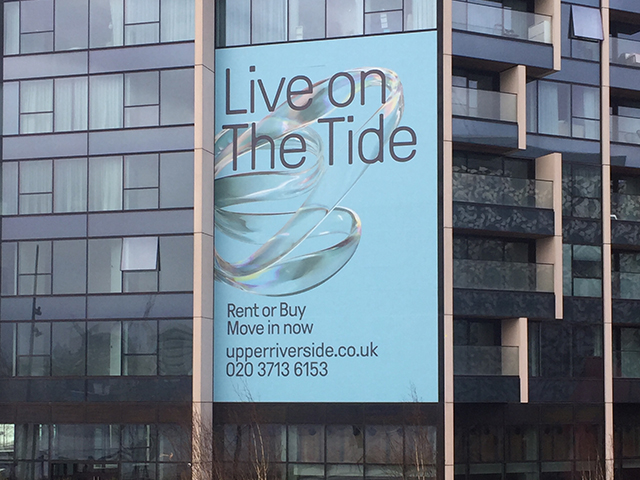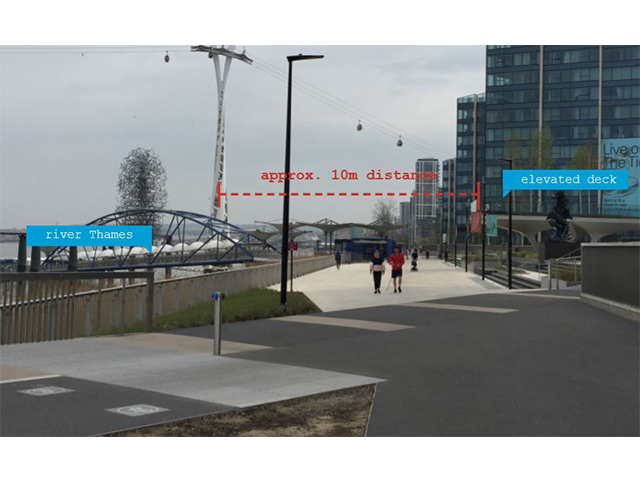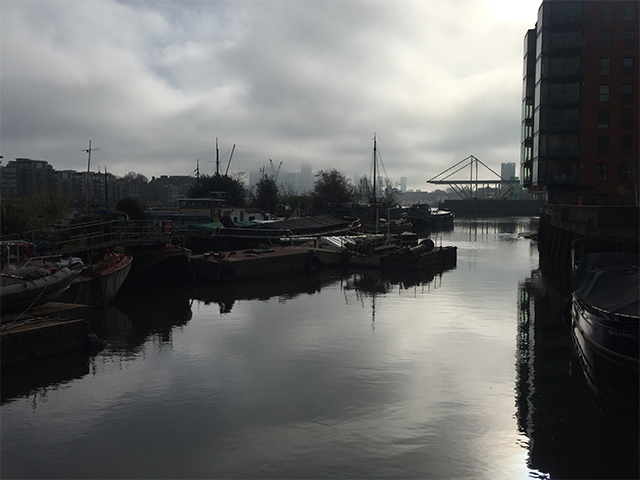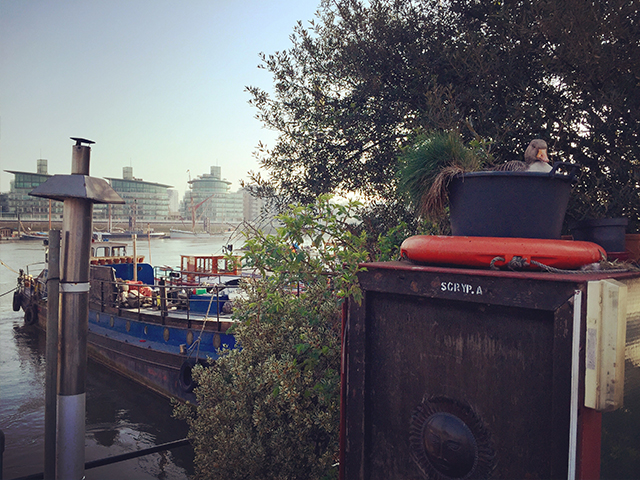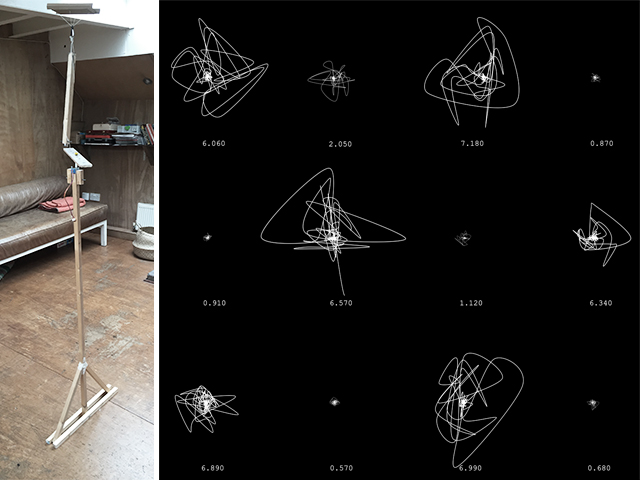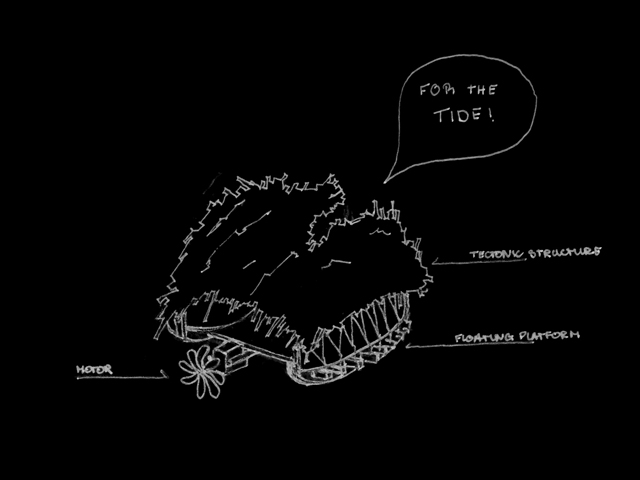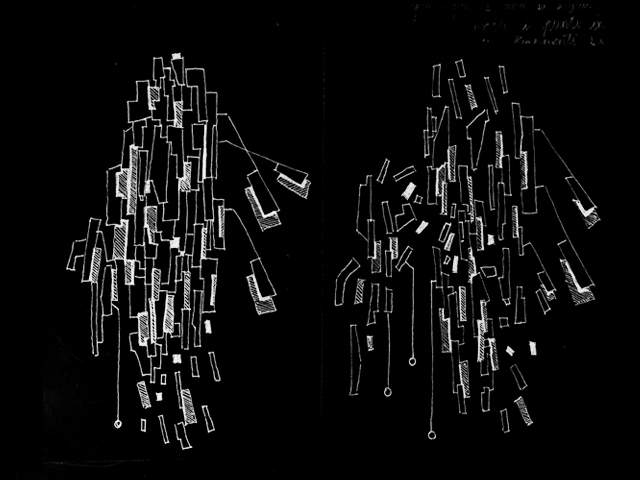For the Tide!
produced by: Gerolamo Gnecchi Ruscone
Abstract
The architect’s obsession with object and form has made space and its inhabitants of secondary interest. Design, navigation, and even simple observation demand a working knowledge and intimacy with space. As humans, we need to become conscious of this space and take responsibility, first and foremost, in design asking questions such as: do buildings address human, and non-human, conditions? Do they interact with their surroundings? What kind of information is being exchanged? Should we continue to build in the service of private or institutional power, or is it time we start thinking of designing with, and not, on space?
Using a recent London-based real estate complex on Greenwich Peninsula as my case study, I will investigate the development as a whole — its architecture, the experience it offers, and its marketing campaign (“Live on the Tide”) — in order to question the validity of its actual relationship to the Thames’ Tide. This will allow us to think about the actual relationship to the Thames and what it means to live on and with the Tide.
I will first research the nature of the Thames Tide, focusing on its ecosystem, the species that inhabit the river, and the invisible fields that act on its shifts and movements. Furthermore, I am going to interview a number of inhabitants that live inside a boat community on the Thames. The interviews will be based on a collection of their experiences addressing the question of how they perceive the Tide. Additionally, using multi-species theory, I will explore how other species perceive the Tide and how they contribute to this complex and rich ecosystem.
I will then imagine what form a deeper engagement between humans and this environment could take: how could we sense the invisible forces (gravitational pull, the pulse of the moon) that cause the Tidal shifts? I will examine and model, through computer and physical simulations, the paths and trails that are created during tidal shifts. And secondly, I will use the findings from my research to propose an alternative habitat, at the scale of a pavilion, speculating on structures that interact and communicate with the Tide’s ecosystem.
In exploring our understanding of an environment — investigating its levels related and un-related to an anthropocentric view and restructuring our intuitive perception based on the forces that control it — we can pave the way toward new horizons in designing and drawing with the Tide.
I believe that we, as architects, designers, and artists, need to liberate ourselves from the habitual, particularly the predominance of the visual, exploring instead new ways of perceiving. Only then will we be able to conceive structures, buildings, objects that create a synergy with the space around us.
Introduction
“The tidal current runs to and fro in its unceasing service, crowded with memories of men and ships it had borne to the rest of home or to the battles of the sea. It had known and served all the men of whom the nation is proud...It had borne all the ships whose names are like jewels flashing in the night of time...It had known the ships and the men...What greatness had not floated on the ebb of that river into the mystery of an unknown earth!”
― Joseph Conrad, Heart of Darkness
While biking on the Thames Path towards Greenwich one day, I noticed dynamic shifts in the city’s landscapes, revealing all of London’s architectural contrasts: from industrial warehouses, to the Tudor’s majestic Palace of Placentia, to residential neighborhoods, to the Thames beaches that uncover themselves during low tide. All of a sudden, I found myself in front of a recent real estate development called the Tide. Beyond the dullness of its architecture — an assemblage of high-rise buildings, overpriced apartments, food chain stores, and a poorly executed replica of New York’s High Line (interestingly conceived by the same architects, Diller-Scofidio & Renfro) — what struck me the most was an advertisement panel attached on one of the façades. It displayed the following words: “Live on the Tide”.
I started asking myself, but what does it mean to live on the Tide? Does this static and banal development acknowledge the Tide’s ecosystem? Do you perceive Tidal shifts when living there? Do you hear the birds singing? Do you hear people walking on the path? Does it relate to this specific river, the Thames, in any way other than its physical proximity? And how would these structures be different if the developers, the architects, applied these notions to the project?
Understanding the spatial implications of an ecosystem and its entanglements is fundamental to the construction of a building, and even more so, of a district. The Thames is a rich ecological community, settled by peoples, traditions, and cultures on the surface and teeming with native and migrant biodiversity beneath, all interconnected and living alongside one another. Good design necessitates respect for this delicate web and subsequent responsibility for any changes we unleash on this environment. Only then we will be able to create a flow, an exchange between what is built and what is surrounding.
It is naive to think that we, as humans, know better. It is ridiculous to be oblivious to our environment. The Tide does not only go up and down. It is not only there for us to watch and observe or to use as a marketing tool. The Thames Tide sways to music we cannot hear, moving in sync with the phases of the moon, changing its currents with the earth’s force of gravity, always continually flowing. It reveals and hides layers of history that none of us could imagine. It is a mystical place.
“Live on The Tide”: A spatial appropriation
“No aquarium, no tank in a marine land, however spacious it may be, can begin to duplicate the conditions of the sea. And no dolphin who inhabits one of those aquariums or one of those marine lands can be considered normal.”
- Jean Yves Cousteau
In 2012, Knight-Dragon, a London-based real estate development, acquired, at a controversial price, Greenwich Peninsula. Since then, they delivered 90000m2 of the built surface around the Peninsula (approximately 500 football fields) with more to come. The site is composed of residential housing, food chain stores, a shopping mall, a design district, and the Tide project — an elevated deck designed by Diller Scofidio & Renfro.
Knight-Dragon is an entity that presents itself in the following terms:
1| “We are entrepreneurial creative-spirited makers of places who bring new ideas and set new standards for urban living...”
2| “As an entrepreneurial urban regenerator and property developer we create places, build properties, and invest in related projects...”
3| “We spot trends, notice opportunities, and see original solutions. With a focus on property, hospitality, and urban lifestyle we use creativity and collaboration to innovate...”
With regards to the Tide, Knight-Dragon suggests that this project is “a layered network of recreation and wellness...” and that “the raised footpath will weave its way around the district in a 5km loop stitching together diverse ecosystems”.
None of what is written above reflects one’s experience when visiting this place. Walking inside the area you notice how every element is disconnected. Formally and structurally, the buildings do not communicate with each other, nor with their surroundings. They are lifeless and serve a singular purpose: to be steel structures that contain luxurious apartments. The trees and green spaces are placed randomly throughout the site. You see the word ‘Tide’ everywhere you go, but you realize soon enough that you are walking on a static concrete pavement. The elevated deck — the intervention that should have connected the river to the complex, “ stitching together diverse ecosystems” — stops approximately 10-15m away from the Thames. The idea of living on and experiencing the Tide vanishes. You tend to forget that you are close to a river. It disengages any possible exchange and connection with the Tide.
Knight-Dragon developed a project without much sense. A flat proposal where the only reflection that comes up is, who could have thought that this was a good idea?1 Little time has been dedicated to “bring new ideas and set new standards for urban living”. Instead, a lot of time has been devoted to understanding the revenue. It is the result of profit-driven urbanization and its relentless commodification and re-commodification of urban spaces.2
Furthermore, as their advertisement panel suggests, one should experience what living on the Tide means, or at least have a glimpse of it. You do get a visual glimpse — when standing at the end of the elevated deck, or inside one of the residential buildings facing the river — which obviously slightly changes your visual perception of the Thames. Yet is this enough to use the motto “Live on The Tide”?
With their elevated deck, the architects, Diller-Scofidio & Renfro, did not manage to bring together the promised “diverse ecosystems”. Their use of an elevated deck responds mainly to Knight-Dragon’s desire — and ultimate failure — to duplicate the High-Line’s impact in New York, rather than the designer’s interpretation and reflections of the Tide.
Neither Knight-Dragon nor the architects captured the essence of the Tide. And most likely, it was never their intention. But regardless of speculative motives, it is the end result that we see and engage with, and the end result of this project is spatial appropriation.
How we construct around space, how we build our environment — from the first strokes of a pen, to the finishing touches of construction on a building — are considerations that beckon the following question: How, for who, and with who, are we designing?
We need to start acknowledging how animals, humans, nature, air, wind, the invisible, transformative fields of the earth, are all inhabitants of the Tide. In this assumption, the Tide is not empty. It is composed of particular elements that interact with each other, forming a continuous flow in which space is constantly changing. These interconnections break assumed boundaries of space and demand a new means of representation in design.
images of the real estate complex photo credit: GGR
The Tide's Ecosystem
What the real estate complex did not recognize is the value of such a rich ecosystem. It is a truly remarkable landscape, vital for connectivity across all channels. The Thames flows from Richmond through London, towards the North Sea, until it eventually meets the Atlantic Ocean. A continuous flow in which distinct trajectories meet each other, enabling a heterogeneous coexistence of animals, nature, and humans.
The river is thus a sphere of dynamic simultaneity, enriched by new arrivals waiting to be determined by the construction of new relations.3 It continuously transforms. The currents change direction because of the wind and the gravitational pull of the moon, shaping and affecting what they encounter. From commercial fishermen to the Thames Barrier, the river constantly alters itself, readapting to our presence, to the artifacts that have been created around this ecosystem.
In this simultaneity, the river’s beauty can be measured through its contrasts and contradictions. There is a discrepancy in the discovery of things. In the Thames, we are as likely to uncover an artifact from prehistoric times as we are to encounter a dead body floating on the surface. It is polluted yet full of wildlife. It is irregular yet systematic, as its Tide constantly exposes the two sides of things. In fact, contradiction lies at the heart of the Thames we know and love today: once an open sewer, it became a flourishing natural environment. Some time ago, in 1957, the Natural History Museum declared the Thames biologically dead.4 Having served London and other cities as an open sewer, it was inevitable that at a certain point “no oxygen was to be found in it for several miles above and below London Bridge”.5 Despite this ill-fated prognosis, it gradually transformed into a space full of life.
The Thames now boasts of prosperous biodiversity, composed of native wildlife as well as migrating species. It is a thriving environment that urges an intimacy with the species that coexist within it — who they are, why they are, and where they do what they do. Only by engaging with these concerns can we, too, play a part in this ecosystem, taking care to not disrupt but rather to contribute to the balance and fluidity. Through this, the Thames becomes our link with the natural and unknown fields of this planet.
It is a mystical river. And we must treat it as such, exploring in more depth the different ways we perceive the Tide to better understand it and create alongside it. When we think of the Tide we tend to have a clear image: it goes up and down, it shifts between low and high, we see its movements. While this conception is not wrong, it limits our knowledge of the Tide. As Juhani Pallasmaa said, “there is a necessity to detach ourselves from the optical predominance”.6 Is it possible to detach ourselves from this visual bias and explore the nuance of the Tide from a different perspective?
image of the Moorings photo credit: GGR
The Moorings
“Isn’t space palpable? isn’t it filled with substance, the air we breathe, and move through and feel like a tangible presence? isn’t this the way we know space? when we feel the wind blowing, we do not say I feel space moving...”
― Lebbeus Woods, Questions on Space
It is not clear when the Moorings actually came into being. At least, I received a lot of different answers to this question. Fifteen to twenty years ago? Fifty years ago? It has always existed? It intrigued me to the point where I started asking myself broader questions that go beyond the scope of this research but unveil in some ways another mystical aspect of this river: What if this place, this spot, this point on the river, has always encountered — through history and in different ways — a community? To what extent do humans, animals, plants decide that space is the right spot to settle and grow? There are many elements to answering this question — protection, exposure to the sun, the aesthetics of a landscape — but I also believe that the memory of a space has an influence on these kind of decisions. The Tide is a continuous cycle that runs on a separate rhythm to life.
Some time ago, a boat community, known as the Moorings, settled itself next to Tower Bridge on the Thames. Composed of a series of old Dutch boats connected by steel pathways and gardens, the community grew, and today there are approximately one hundred inhabitants living on this floating village. Housing families to young creatives, this floating micro-society offers a unique example in understanding how humans perceive the Tide differently, from a multi-sensorial perspective in addition to a visual one.
From cooking while being on low tide to draw while being in a space in motion to simply feeling the pulses of the moon, the inhabitants of the Moorings perceive and experience the Tide in a daily manner unbeknownst to those outside its gates. I am going to share with you some of these unique stories.
Link to interviews: https://issuu.com/gerolamognecchi/docs/interviews_for_the_tide
Other inhabitants of The Moorings
"The Language of perspective carries with it weighty assumptions about what it means to understand other minds...Within the model of a world divided up into the objective and the subjective, and armed with the method of sympathetic projection, understanding another mind could only mean seeing with another’s eyes (or smelling another’s nose or hearing with another’s sonar...) put yourself in his place..."
― Lorraine Daston
For a broader understanding of this ecosystem, it is important to recognize that there are other species around us and that we must engage with both human and animal perception to pave new horizons with the Tide. We know that beyond our five senses there are diverse mechanisms of sensing and perceiving. Research on animal perception is extensive and offers insight into the limits of the five human senses. From detecting gravity and the earth’s magnetic fields to feeling heat and the movement of water, animals have the ability to do much more than just see, smell, touch, and hear. I believe that humans can too.
This does not mean that we should adopt or use the animal’s perception as a tool for design, putting oneself in the animal’s shoes or vice versa, since it is a dangerous filtration with anthropomorphism.7 But rather, we need to find a way to develop a design for multi-species coexistence.
From geese to ducks and seagulls, from the imperceptible fishes that live underwater — the ancient lampreys and their look-alike modern counterparts, eels — to the occasional fox who manages to access the Moorings during low Tide, these are only some of the inhabitants that coexist with humans in this unique micro-society. As a person who has lived most of his life in cities, I have never before experienced such daily close encounters with certain animals.
There is a lot to learn from this place.
images of the Moorings photo credit: GGR
The Tide’s invisible field
"There is a side of the Moon which we never see, but that hidden half is as potent a factor in causing the ebb and flow of the Earth’s tide as the part of the Moon which is visible."
-Max Heindel
Tidal shifts are the rise and fall of sea levels caused by the combined effects of the gravitational forces exerted by the Moon and the Sun on the rotation of the Earth. The Thames Tide experiences two high and two low Tides within a twenty-four hour period. As a first experiment, I abstractly visualized these moments, implementing code with a month of data on Tidal shifts. Secondly, through a physical pendulum attached to one of the boat’s ceilings, I recorded and visualized in real-time the paths that occur during Tidal shifts. The idea of using a pendulum as an instrument was for the simple purpose it serves: when released, it swings and oscillates freely, it is subject to the movements of the boat. Consequently, I will also add a magnetic field under the tip of the pendulum to create an unexpected momentum.
pendulum installation visualizing its paths while oscillating during tidal shifts
A voice for the Tide!
Based on the above research, I propose an alternative design aimed at evoking a deeper awareness and interaction between humans and the Tidal environment.
Flowing with the Tide, the design is a floating platform holding an oscillating structure. The structure will act as a field, a swarm of pendulums, and respond to the changing state of the river. It is a transformative space made of tectonic elements, for humans and non humans to experience. The exchange between the oscillating pavilion and the rise and fall of the river, will also generate sounds giving a voice for the Tide!
1|hand sketch of floating platform 2| abstract hand sketches of transformative structures 3| hand sketch of possible oscillating structure
Annotated Bibliography
1| ‘London’s answer to new york’s high line? You must be joking’ by Oliver Wainwright The Guardian Wed 10 Jul 2019
Wainwright's article is a critique of the real estate development “The Tide”.
2| ‘Cities for People, Not for Profit: Critical Urban Theory and the Right to the City’ by Neil Brenner 2011 Routledge
A collection of essays giving the reader a clear vision of how developers, the process of gentrification, and other aspects of capitalism affect contemporary cities.
3| ‘For Space’ by Doreen Massey 2005 Sage publication Ltd
An incredible thesis on how we should renew our relationship to space and consequently how we should approach it.
4| ‘How the River Thames was brought back from the dead’ by Sophie Hardach BBC Earth Wed 12 Nov 2015
An interesting collection of facts about the Thames.
5| ibid
6| ‘The Thinking Hand: Existential and Embodied Wisdom in Architecture’ by Juhani Pallasmaa 2009 John Wiley & Sons
Pallasmaa critiques the predominance of visual perception and how we should explore and be aware of our other senses.
7| ‘Responding Bodies and Partial Affinities in Human Animal Worlds’ by Vincianne Despret 2013 Research Article
Research on how scientists used their bodies to understand and engage with non-humans.
Bibliography
‘Space and Spatial Cognition : A Multidisciplinary Perspective’ by Michel Denis 2018 Routledge
‘The Thinking Hand : Existential and Embodied Wisdom in Architecture’ by Juhani Pallasmaa 2009 John Wiley & Sons
‘For Space’ by Doreen Massey 2005 Sage publication Ltd
‘Cities for People, Not for Profit: Critical Urban Theory and the Right to the City’ by Neil Brenner 2011 Routledge
‘Responding Bodies and Partial Affinities in Human Animal Worlds’ by Vincianne Despret 2013 Research Article
‘London’s answer to new york’s high line? You must be joking’ by Oliver Wainwright The Guardian Wed 10 Jul 2019
‘How the River Thames was brought back from the dead’ by Sophie Hardach BBC Earth Wed 12 Nov 2015
link to the research paper on issuu: http://issuu.com/gerolamognecchi/docs/the_tide

































































